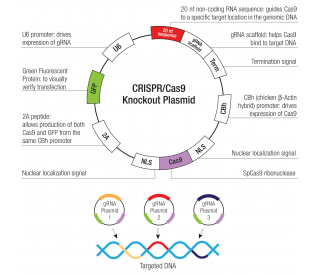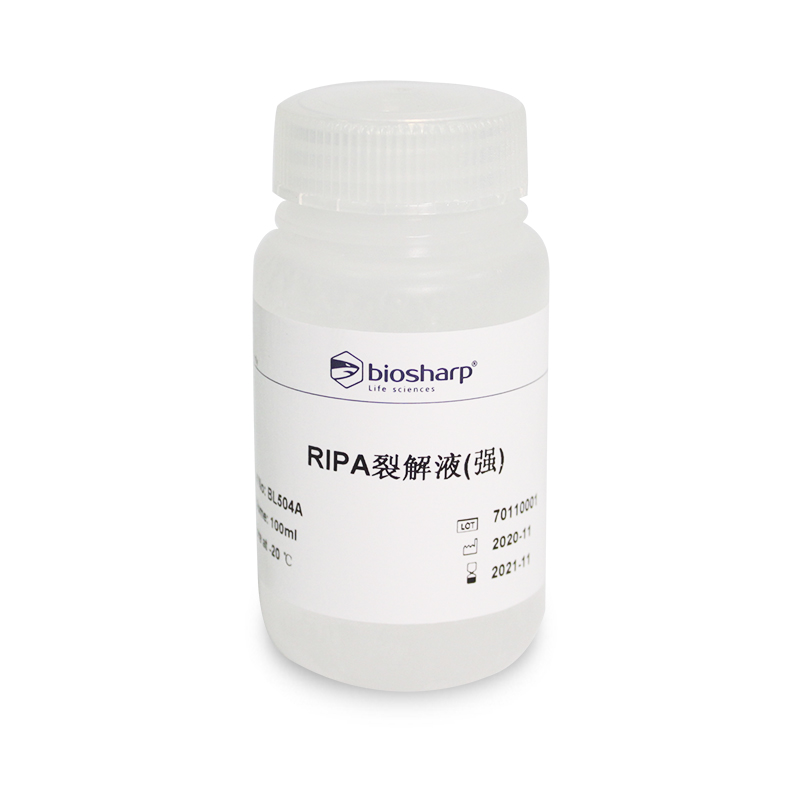-
- Target species: mouse
- Plasmids consists of FAT4-specific 20 nt guide RNA sequences derived from the GeCKO (v2) library
- gRNA sequences direct the Cas9 protein to induce a site-specific double strand break (DSB) in the genomic DNA
- All products are provided as transfection-ready, purified plasmid DNA, except the Lentiviral Activation Particles which have been prepackaged as Lentiviral Particles for use with hard-to-transfect cells
Description
See Protocol Online.
HDR Plasmid- 20 µg of transfection-ready, purified plasmid DNA; Suitable for up to 20 transfections
- FAT4 CRISPR/Cas9 Knockout (KO) Plasmid (m) consists of a pool of three plasmids each encoding the Cas9 nuclease and a FAT4-specific 20 nt guide RNA (gRNA) designed for maximum knockout efficiency
- gRNA sequences are derived from the GeCKO (v2) library and direct the Cas9 protein to induce a site-specific double strand break (DSB) in the genomic DNA
- For selection of cells containing a successful Cas9-induced DSB, co-transfection with FAT4 HDR Plasmid (m) (sc-435960-HDR) is recommended
- contact Technical Service for availability of control antibody
See Protocol Online.
Description
See Protocol Online.
Double Nickase Plasmids- 20 µg of transfection-ready, purified plasmid DNA; Suitable for up to 20 transfections
- FAT4 HDR Plasmid (m) is recommended for co-transfection with FAT4 CRISPR/Cas9 KO Plasmid (m)
- FAT4 HDR Plasmid (m) consists of a pool of 2-3 plasmids, each containing a homology-directed DNA repair (HDR) template corresponding to the cut sites generated by the FAT4 CRISPR/Cas9 KO Plasmid (m)
- Each HDR plasmid contains two 800 bp homology arms designed to specifically bind to the genomic DNA surrounding the corresponding Cas9-induced double strand DNA break site
- Each HDR Plasmid inserts a puromycin resistance gene to enable selection of stable knockout (KO) cells and an RFP (Red Fluorescent Protein) gene to visually verify transfection
- The puromycin resistance and RFP genes are flanked by two LoxP sites to allow for further processing by the Cre Vector sc-418923
See Protocol Online.
Description
See Protocol Online.
CRISPR Activation Plasmids- 20 µg of transfection-ready, purified plasmid DNA; Suitable for up to 20 transfections
- FAT4 Double Nickase Plasmid (m) consists of a pair of plasmids each encoding a D10A mutated Cas9 nuclease and a target-specific 20 nt guide RNA (gRNA) designed to knockout gene expression with greater specificity than its CRISPR/Cas9 KO counterpart
- Paired gRNA sequences are offset by approximately 20 bp to allow for specific Cas9-mediated double nicking of the genomic DNA, which mimics a DSB
- One plasmid in the pair contains a puromycin-resistance gene for selection; the other plasmid in the pair contains a GFP marker to visually confirm transfection
- The paired gRNAs encoded by FAT4 Double Nickase Plasmid (m2) differ from the paired gRNAs in FAT4 Double Nickase Plasmid (m)
See Protocol Online.
Description
See Protocol Online.
Lentiviral Activation Particles- 20 µg of transfection-ready, purified plasmid DNA; Suitable for up to 20 transfections
- FAT4 CRISPR Activation Plasmid (m) is a synergistic activation mediator (SAM) transcription activation system designed to specifically upregulate gene expression
- FAT4 CRISPR Activation Plasmid (m) consists of three plasmids at a 1:1:1 mass ratio: a plasmid encoding the deactivated Cas9 (dCas9) nuclease (D10A and N863A) fused to the transactivation domain VP64, and a blasticidin resistance gene; a plasmid encoding the MS2-p65-HSF1 fusion protein, and a hygromycin resistance gene; a plasmid encoding a target-specific 20 nt guide RNA, and a puromycin resistance gene
- The resulting SAM complex binds to a site-specific region approximately 200-250 nt upstream of the transcriptional start site and provides robust recruitment of transcription factors for highly efficient gene activation
- The sgRNA (MS2) plasmid in FAT4 CRISPR Activation Plasmid (m2) encodes a target-specific 20 nt guide RNA that differs from the guide RNA in FAT4 CRISPR Activation Plasmid (m)
See Protocol Online.
Description
See Protocol Online.
- 200 µl of transduction-ready, high-titer CRISPR/dCas9 Lentiviral Activation Particles
- FAT4 Lentiviral Activation Particles (m) is a synergistic activation mediator (SAM) transcription activation system designed to specifically and efficiently upregulate gene expression via lentiviral transduction of cells
- FAT4 Lentiviral Activation Particles (m) contain the following SAM Activation elements: a deactivated Cas9 (dCas9) nuclease (D10A and N863A) fused to the transactivation domain VP64, an MS2-p65-HSF1 fusion protein and a target-specific 20 nt. guide RNA. They also contain the blasticidin, hygromycin and puromycin resistance genes
- Upon transduction, the SAM complex binds to a site-specific region approximately 200-250 nt. upstream of the transcriptional start site and provides robust recruitment of transcription factors for highly efficient gene activation
- The guide RNA in the FAT4 Lentiviral Activation Particles (m2) encodes a target-specific 20 nt guide RNA that differs from the guide RNA in FAT4 Lentiviral Activation Particles (m)
See Protocol Online.










